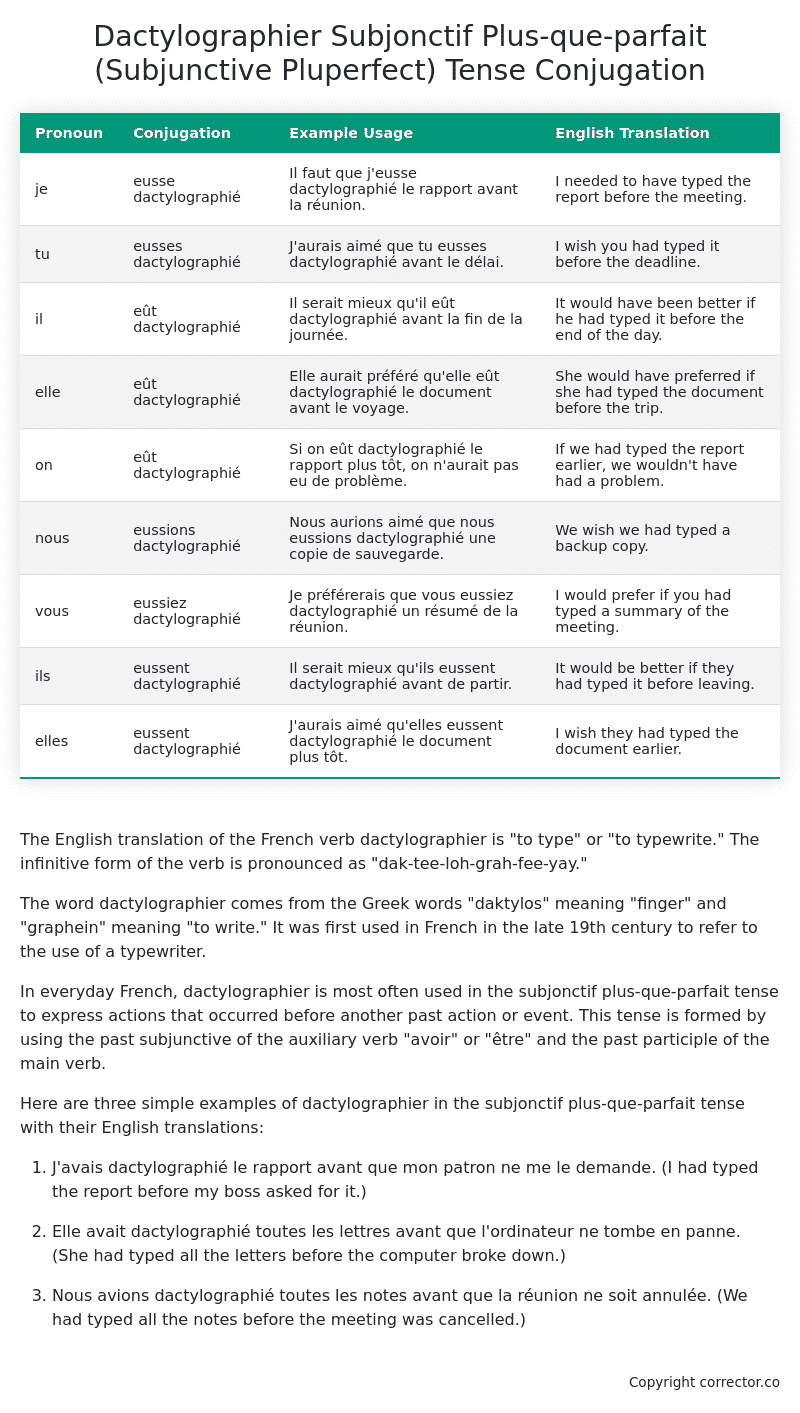Subjonctif Plus-que-parfait (Subjunctive Pluperfect) Tense Conjugation of the French Verb dactylographier
Introduction to the verb dactylographier
The English translation of the French verb dactylographier is “to type” or “to typewrite.” The infinitive form of the verb is pronounced as “dak-tee-loh-grah-fee-yay.”
The word dactylographier comes from the Greek words “daktylos” meaning “finger” and “graphein” meaning “to write.” It was first used in French in the late 19th century to refer to the use of a typewriter.
In everyday French, dactylographier is most often used in the subjonctif plus-que-parfait tense to express actions that occurred before another past action or event. This tense is formed by using the past subjunctive of the auxiliary verb “avoir” or “être” and the past participle of the main verb.
Here are three simple examples of dactylographier in the subjonctif plus-que-parfait tense with their English translations:
-
J’avais dactylographié le rapport avant que mon patron ne me le demande. (I had typed the report before my boss asked for it.)
-
Elle avait dactylographié toutes les lettres avant que l’ordinateur ne tombe en panne. (She had typed all the letters before the computer broke down.)
-
Nous avions dactylographié toutes les notes avant que la réunion ne soit annulée. (We had typed all the notes before the meeting was cancelled.)
Table of the Subjonctif Plus-que-parfait (Subjunctive Pluperfect) Tense Conjugation of dactylographier
| Pronoun | Conjugation | Example Usage | English Translation |
|---|---|---|---|
| je | eusse dactylographié | Il faut que j’eusse dactylographié le rapport avant la réunion. | I needed to have typed the report before the meeting. |
| tu | eusses dactylographié | J’aurais aimé que tu eusses dactylographié avant le délai. | I wish you had typed it before the deadline. |
| il | eût dactylographié | Il serait mieux qu’il eût dactylographié avant la fin de la journée. | It would have been better if he had typed it before the end of the day. |
| elle | eût dactylographié | Elle aurait préféré qu’elle eût dactylographié le document avant le voyage. | She would have preferred if she had typed the document before the trip. |
| on | eût dactylographié | Si on eût dactylographié le rapport plus tôt, on n’aurait pas eu de problème. | If we had typed the report earlier, we wouldn’t have had a problem. |
| nous | eussions dactylographié | Nous aurions aimé que nous eussions dactylographié une copie de sauvegarde. | We wish we had typed a backup copy. |
| vous | eussiez dactylographié | Je préférerais que vous eussiez dactylographié un résumé de la réunion. | I would prefer if you had typed a summary of the meeting. |
| ils | eussent dactylographié | Il serait mieux qu’ils eussent dactylographié avant de partir. | It would be better if they had typed it before leaving. |
| elles | eussent dactylographié | J’aurais aimé qu’elles eussent dactylographié le document plus tôt. | I wish they had typed the document earlier. |
Other Conjugations for Dactylographier.
Le Present (Present Tense) Conjugation of the French Verb dactylographier
Imparfait (Imperfect) Tense Conjugation of the French Verb dactylographier
Passé Simple (Simple Past) Tense Conjugation of the French Verb dactylographier
Passé Composé (Present Perfect) Tense Conjugation of the French Verb dactylographier
Futur Simple (Simple Future) Tense Conjugation of the French Verb dactylographier
Futur Proche (Near Future) Tense Conjugation of the French Verb dactylographier
Plus-que-parfait (Pluperfect) Tense Conjugation of the French Verb dactylographier
Passé Antérieur (Past Anterior) Tense Conjugation of the French Verb dactylographier
Futur Antérieur (Future Anterior) Tense Conjugation of the French Verb dactylographier
Subjonctif Présent (Subjunctive Present) Tense Conjugation of the French Verb dactylographier
Subjonctif Passé (Subjunctive Past) Tense Conjugation of the French Verb dactylographier
Subjonctif Imparfait (Subjunctive Imperfect) Tense Conjugation of the French Verb dactylographier
Conditionnel Présent (Conditional Present) Tense Conjugation of the French Verb dactylographier
Conditionnel Passé (Conditional Past) Tense Conjugation of the French Verb dactylographier
L’impératif Présent (Imperative Present) Tense Conjugation of the French Verb dactylographier
L’infinitif Présent (Infinitive Present) Tense Conjugation of the French Verb dactylographier
(this article)
Struggling with French verbs or the language in general? Why not use our free French Grammar Checker – no registration required!
Get a FREE Download Study Sheet of this Conjugation 🔥
Simply right click the image below, click “save image” and get your free reference for the dactylographier Subjonctif Plus-que-parfait tense conjugation!

Dactylographier – About the French Subjonctif Plus-que-parfait (Subjunctive Pluperfect) Tense
Formation
Common Everyday Usage Patterns
Hypothetical Situations
Reported Speech
Doubt, Wishes, and Emotions
Interactions with Other Tenses
Present Subjunctive
Imperfect Subjunctive
Conditional
Summary
I hope you enjoyed this article on the verb dactylographier. Still in a learning mood? Check out another TOTALLY random French verb conjugation!


